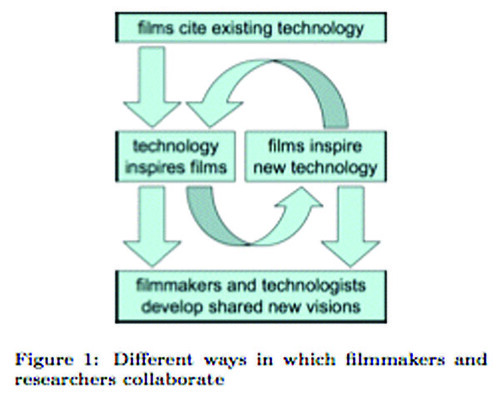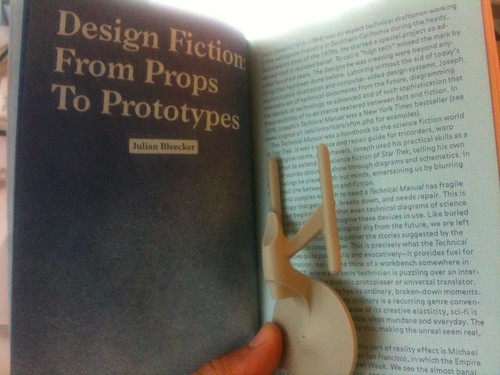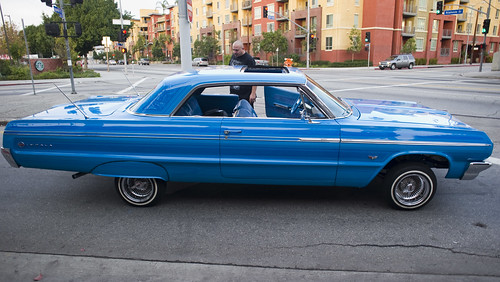<a href="http://twitter.com/bruces/status/24029892488"?@bruces pointed out this curious paper called Modifiable Futures: Science Fiction at the Bench from Colin Milburn, who sits in the Program in Science and Technology Studies that our old UCSC History of Consciousness school chumJoe Dumit heads. The paper takes a go at describing the entangled, multivalent, contentious and complex relationship between science, fact, fiction and the future. The interplay between all of these — and throw in fan cultures, society at large, politics, money, power, knowledge and authority..heck, lets just say “technoscience” and be done with the litanies — is a tricky thing to describe and always seems to make people hot under the collar lest capital-s Science feel it looses its authority as the canonical, go-to guy for where knowledge about the world comes from.
What Milburn might say — what many who appreciate the fun to be found in the rich layer cake of knowledge production — is that the interplay between fiction and fact is actually a good thing. He would say that the assumption that scientist, their ideas and their divinations in the form of science facts about the natural world is not only wrong, but it does a disservice by discounting the productive contributions that other idea-generating mechanisms can bring to the game of knowledge-production. And for Milburn, curiously — games provides a fruitful framework for his way of describing the interplay between science fact and science fiction. He uses the game “mod” — or modification — as a metaphor for the way that science fact and science fiction produce knowledge and materialize ideas.
“In many ways, the day-to-day activities of laboratory science resemble some of these fan practices: sampling from and building on the work of others, taking what was successful in one experiment and applying it elsewhere, proceeding through imitation, eclectic opportunism, bricolage, and so forth. So with such fan practices in mind, I would like to suggest that our understanding of how science fiction works at the bench would be greatly improved by seeing scientists as cultural consumers like any culture consumers, perhaps even in some cases as science fiction fans like any science fiction fans, but having at their disposal the tools and the resources for making science fiction and other cultural materials actually usable for science — and vice versa.”

This is an intriguing perspective for its simplicity, which is good. The simplicity should be contrasted with the oftentimes baroque offerings of explanation delivered by critical theory (and worse..philosophy) when brought to bear on the world of science, or epistemology of science. By drawing from more contemporary ideas about fan culture and then saying — hey..scientists can be science fiction fans, too, Milburn is stating what would seem obvious. (Obvious, but breeching the perimeter of scientists’ secret lair can be dangerous — cf the “Science Wars
” — and “The Science Wars ” that waged in the 90’s amongst about 300 people..it got down-right nasty! Seriously..you could write a movie script from the back-biting, the misrepresentations, the gaffs and punk’ngs — the whole FBI thing interviewing historians of science at their annual conference about the where-for of the Unabomer? But..only 300 people would go see the movie..still, exciting for a clutch of Ph.D.s.)
” that waged in the 90’s amongst about 300 people..it got down-right nasty! Seriously..you could write a movie script from the back-biting, the misrepresentations, the gaffs and punk’ngs — the whole FBI thing interviewing historians of science at their annual conference about the where-for of the Unabomer? But..only 300 people would go see the movie..still, exciting for a clutch of Ph.D.s.)
*Anyway.
Milburn is stating that scientists should not be exempt from fandom and the larger influences of the ideas that are heavily circulated in various forms of science fiction cultures, entertainment even as they are distilled and decanted through various means that themselves may not be categorized as “science fiction.” It’s not like they ignore their imaginations, which might have caught wind of — or even been inspired by — say..Star Wars or Minority Report or Raumpatrouille Orion or Space 1999.
Milburn then goes on to say that the idea of the “mod” — the modification like the game mod, or the music mash-up, “fanfic” style grassroot storytelling that responds to the desires of fans and so on — all of these *ways of circulating and generating new music/stories/conversations should perhaps suggest that the same can happen with science when fact and fiction engage each other. Milburn describes three kinds of mods for science fiction that make it fruitfully usable by technoscience (in other words — he’s not dissing science but rather seems to be suggesting that science fact becomes better for being able to push itself beyond its own institutional limits by engaging science fiction productively): blueprint mods, supplementary mods and speculative mods.
Blueprint mods translate a specific, discrete element of science fiction and attempt to materialize it as a technical reality. The relevant example he gives is of Linden Labs using Neal Stephenson’s Snow Crash as a model for their Second Life as described in the book Making Virtual Worlds: Linden Lab and Second Life
as a model for their Second Life as described in the book Making Virtual Worlds: Linden Lab and Second Life . The blueprint mod goes beyond using the science fiction as an influence or inspiration — it wants to make something that is quite specific in the text, “extrapolating and inventing a distinct technical dimension..disregarding any necessary integrity or organicity of the fiction.” Milburn mentions the seemingly endless fascination of this form of “mod” with entire book series
. The blueprint mod goes beyond using the science fiction as an influence or inspiration — it wants to make something that is quite specific in the text, “extrapolating and inventing a distinct technical dimension..disregarding any necessary integrity or organicity of the fiction.” Milburn mentions the seemingly endless fascination of this form of “mod” with entire book series and Wiki pages devoted to “The Science of..” show/movie/book.
and Wiki pages devoted to “The Science of..” show/movie/book.
Supplementary mods attempt to approximate a science fiction concept. This means that what sounds cool but is taken to be technically impossible will be worked on to create a scientifically viable alternative. There has been work on invisibility shields that fall into this category of supplementary mods. For example, this invisibility cloak that is evocative of the cloak that P.K. Dick’s Agent Fred wears in A Scanner Darkly . I saw this device at Ars Electronica in 2008 — it is definitely an approximation but tips into this sort of supplementary mod. It seems to say — this is a very cool idea. We know it is technically intractable, but we’re going to push forward anyway with this project that begins to activate the imagination and inspire further modding.
. I saw this device at Ars Electronica in 2008 — it is definitely an approximation but tips into this sort of supplementary mod. It seems to say — this is a very cool idea. We know it is technically intractable, but we’re going to push forward anyway with this project that begins to activate the imagination and inspire further modding.
Speculative mods is where science fiction is used in science writing and technical papers as a way of describing possible futures and the extrapolation of today into tomorrow. This is a form I find quite often — the “it’s like the ray gun in Lost In Space” sort of thing. Milburn acknowledges that that historians and cultural theorists of technoscience appreciate how science speculation, “forecasting”, futurological narratives, road mapping and so on play a role as “scripts” in the laboratory and R&D agendas. But, he says —
“..we have yet fully to take on the manifold ways these practices interrelate with the predominant mode of speculative narration in the modern era — namely, science fiction. Its generic traces can often be discerned where scientific probabilities or expectations for the future are rendered as discourse, as a now quotidian way of speaking about the consequences of scientific or technological change: the everydayness in postindustrial societies of what..has been called ‘science fiction thinking’..”
Why do I blog this? This is a great short essay that captures some of the themes of the design fiction conversations that are swirling about here and there. There’s some useful reinforcement of things that David A. Kirby has described as the “diegetic prototype” — which I think is kin to Milburn’s idea of the mod, insofar as it allows for the circulation of ideas and does not explicitly prioritize either fact or fiction.
What I find interesting is the use of the idea of the mod — a form of circulating and layering cultural forms to create something that builds upon some underlying stories and characters and worlds that are ostensibly fiction to make something material and tangible that is ostensibly fact. And then when you understand the rich ways in which ideas blur together and you stop prioritizing the fact/fiction binary — you begin to see new possibilities for imagining and creating and materializing ideas that avoids those silly cat fights over who done what first or who was the originator or an idea.
Continue reading The Future is a Mod





Design Fiction: From Props To Prototypes
Franz Joseph was an expert technical draftsman working in the aerospace industry in Southern California during the heady, Skunkworks days of the 1970s. He started a special project — so advanced that it taunted belief. To call it “high tech” missed the mark by a few hundred years. The designs he was creating were beyond anything that had been done before. Laboring without the aid of today’s sophisticated illustration and computer-aided design systems, Joseph created a set of technical documents from the future, diagramming the details of technology so advanced and of such sophistication that the possibility of its existence teetered between fact and fiction. In 1976, it was a New York Times best selling book.
Joseph’s Technical Manual was a DIY shop manual for the science fiction world of Star Trek. It was a service and repair guide for tricorders, warp drive engine rooms and phasers. Joseph used his practical skills as a draftsman to extend the science fiction of Star Trek, telling his own sorts of stories about Star Trek through diagrams and schematics. In his drawings he played with our minds, entertaining us by blurring the broad line between fact and fiction.
A world with a Technical Manual has complex, fragile technology like tricorders and communicators and captain’s chairs that gets used by people and breaks down and needs repair. This is where we begin to realize that even technical diagrams of science fiction props can help us imagine these devices in use. Like buried artifacts found in an archeological dig from the future, we are left to fill in the gaps and knit together the stories suggested by the peculiar objects he drew. This is precisely what the Star Trek Technical Manual does quite powerfully and evocatively — it provides fuel for the imagination, making one think of a workbench somewhere in the year 2300 where a scrawny technician is puzzling over an intermittently functioning anabolic protoplaser or universal translator. Even fantastic technology has its ordinary, broken down moments.
Making the extraordinary ordinary is a recurring genre convention for science fiction. Because of its creative elasticity, sci-fi is able to make strange, implausible ideas mundane and everyday. The Technical Manual does precisely this, making the unreal seem real, even routine and plain.
A favorite viral example of this sort of reality effect is Michael Horn’s short film “Death Star over San Francisco” in which the Empire visits San Francisco during Fleet Week. We see the almost banal spectacle of an Imperial Trooper, 10 meters up on an AT-ST, poking his head out of the hatch and coaxing a passerby to toss up something they’ve dropped on the street, perhaps the keys to start the walker. Elsewhere we see a transport making a landing on the roof of an apartment building, as ordinary as anything you might see around San Francisco. The footage is rough and un-produced, with off-camera banter about barbecues and the rustle of wind on a microphone, clearing the way for us to imagine this as the product of an everyday tourist out and about during a holiday weekend. Another example of a similar kind of reality effect is filmmaker Floris Kaayk’s fictional documentary “Metalosis Maligna.” Kaayk “documents” a disease that arises from the widespread proliferation of metal implants. Visually, it plays tricks on us, forcing us to consider the reality of this condition. By using the conventions of the documentary — talking head experts, dramatic footage of people suffering horrific metal lattices protruding from their bodies, reserved voice over commentary, and so on — we are drawn into the possibility of this slightly sinister malignancy. Our willingness to accept a strange, otherworldly circumstance is heightened by the visually compelling short story.
The simple brilliance of these short films are similar to Joseph’s specific kind of diagrammatic creative story telling. They all teeter playfully between fact and fiction. These design fictions stretch the constraints of reality by taking the genre conventions of holiday videos or technical drawing and using these conventions to unassumingly fill out the contours of a slightly real, slightly fictional world. They allows for a different kind of engagement with a speculative idea. They draw it out, specifying it “as if” it were part of the world already. The Technical Manual, like “Death Star over San Francisco” lives somewhere in between speculation and materialization, in between an idea and that idea put in the hand to ponder over and consider. The fiction comes off the screen just a bit and gets closer to reality. The props become imminent, forcing one to consider to look sideways and consider that things could be otherwise.
In this way, the Technical Manual makes me think about new ways of making, creating and prototyping. It would be useful in the design world to prototype things in a way that help us imagine and wonder, and consider unexpected, perhaps transformative alternatives. Rather than the canonical technical prototype that operates as an engineering proof of feasibility, what about prototypes that are more like props? Material things, off the page and in the hand that help tell a story or start a conversation
This kind of prototype has nothing to prove — they do not represent technical possibility. They are prototypes that give shape and form and weight to one’s imagined idea. This is a kind of prototyping that couples the speculation inherent in design with the creative license of fiction and the pragmatic, imminent reality of fact. Tangible, materialized props that live in between fact and fiction and are both speculative and possible. They aren’t specifications for making, but they are specifications for imagining. These are prototypes that express possibility more powerfully than either fact or fiction could do if they were each left to their own intellectual and creative provinces. This deliberate blurring of fact and fiction is what we have been calling “design fiction.” Fiction borrowing from fact and thereby rethinking and re-imagining what may be possible.
Design fiction is a way to speculate seriously. It’s not quite brainstorming, nor is it ideating. It is design that tells stories. It creates material artifacts that force conversations and suspend one’s disbelief in what could be. It’s a way of imagining a different kind of world by outlining the contours, rendering the artifacts as story props, then using them to imagine. The prototyping activates the idea, giving it a few material features and some density, and forcing the refinement that comes from making something.
That in-between is what Joseph captures in his design-fiction mechanical drawings. The sparseness of words contrasts with the drawing details in such a way that we are forced to wonder about the implicit sophistication of these devices. Are they real? Where and when did this manual come from? These questions are forced upon the reader to interpret. This is the seduction of design-fiction at its best. The reader has to fill in the gaps and in the filling-in of gaps, we are made to imagine and wonder. And with these questions evolves a conversation that does not stop simply at the pragmatic, and does not dismiss as silly or impossible the fruits of imagining.
References:
Mike Horn Death Star Over San Francisco
http://vimeo.com/2587071
Star Trek Star Fleet Technical Manual, Franz Joseph (short link to book)
http://amzn.to/9L8JBW
Floris Kaayk’s Metalosis Maligna
http://vimeo.com/1192666
Marjolijn Dijkman Wandering through the future (2007)
http://www.marjolijndijkman.com/projects/view/1/132
Bruce Sterling’s Design Fiction Category List:
http://www.wired.com/beyond_the_beyond/category/design-fiction/
Near Future Laboratory Design Fiction Chronicles Category List
http://www.nearfuturelaboratory.com/category/design/design-fiction/
Near Future Laboratory Design Fiction: A Short Essay on Design, Science, Fact and Fiction
http://www.nearfuturelaboratory.com/2009/03/17/design-fiction-a-short-essay-on-design-science-fact-and-fiction/
SXSW Design Fiction Panel Audio
http://audio.sxsw.com/2010/podcasts/031310i_designFiction.mp3